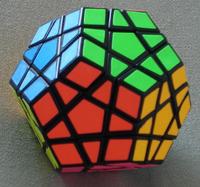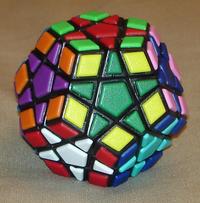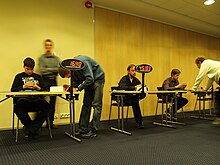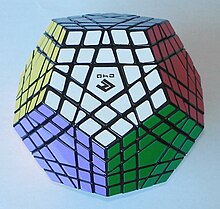This is an old revision of this page, as edited by Mvpo666 (talk | contribs) at 21:09, 20 January 2014. The present address (URL) is a permanent link to this revision, which may differ significantly from the current revision.
Revision as of 21:09, 20 January 2014 by Mvpo666 (talk | contribs)(diff) ← Previous revision | Latest revision (diff) | Newer revision → (diff)

The Megaminx (also spelled Mégaminx) is a dodecahedron-shaped puzzle similar to the Rubik's Cube. It has a total of 50 movable pieces to rearrange, compared to the 20 movable pieces of the Rubik's Cube.
History
The Megaminx, or Magic Dodecahedron, was invented by several people independently and produced by several different manufacturers with slightly different designs. Uwe Mèffert eventually bought the rights to some of the patents and continues to sell it in his puzzle shop under the Megaminx moniker. It is also known by the name Hungarian Supernova, invented by Dr. Cristoph Bandelow. His version came out first, shortly followed by Meffert's Megaminx. The proportions of the two puzzles are slightly different.
Description
The Megaminx is made in the shape of a dodecahedron, and has 12 face center pieces, 20 corner pieces, and 30 edge pieces. The face centers each have a single color, which identifies the color of that face in the solved state. The edge pieces have two colors, and the corner pieces have three colors. Each face contains a center piece, 5 corner pieces and 5 edge pieces. The corner and edge pieces are shared with adjacent faces. The face centers can only rotate in place, but the other pieces can be permuted by twisting the face layer around the face center.
There are two main versions of the Megaminx: the 6-color version in which opposite faces have the same color, and the 12-color version in which all faces have a different color.
The purpose of the puzzle is to scramble the colors, and then restore it to its original state of having one color per face.
Solutions
The 6-color Megaminx comes with an additional challenge to the 12-colour puzzle which is not immediately obvious. Its edge pieces come in visually identical pairs, because of the duplicated colors of opposite faces. However, although visually indistinguishable, they are nevertheless mathematically bound in a parity relationship. In any legal position (reachable from the solved state without disassembling the puzzle), there is always an even number of swapped pairs of edges. However, since swaps may be between visually indistinct edges, one may find that having solved almost the entire puzzle, one is left with a pair of swapped (distinct) edges that seems to defy all attempts to exchange them. The solution is to swap a single pair of 'identical' edges to reverse the parity, and then restore the rest of the puzzle.
This property is absent in the 12-color Megaminx, because all its edges are visually distinct, and it would be immediately obvious that there is another pair of swapped edges besides the pair one is working with.
Besides solving a Megaminx the regular way, patterns can be made on it just like a Rubik's Cube. Examples of these include a star, checkerboard, and pentagon in a pentagon patterns.
Number of combinations
Both versions of the puzzle have 20 corners and 30 edges. In both cases, only even permutations are possible, regardless of the position of the other set of pieces. Thus, while it is possible to have two corners or two pairs of edges swapped on a Rubik's Cube, this is impossible on the Megaminx. There are 20!/2 ways to arrange the corners and 3 ways to orient them, since the orientation of the last corner depends on that of the preceding ones. There are 30!/2 ways to arrange the edges and 2 ways to flip them.
The full number is 100 669 616 553 523 347 122 516 032 313 645 505 168 688 116 411 019 768 627 200 000 000 000 (roughly 101 unvigintillion on the short scale or 101 undecillion on the long scale).
The corners are distinguishable on a six-color Megaminx because two corners with the same three colors will be mirror images of each other. There are 15 pairs of identical edges. It would not be possible to swap all 15 pairs, since this would be an odd permutation of the edges, so a reducing factor of 2 is applied to the preceding figure.
The full number is 6 144 385 775 971 883 979 645 753 925 393 402 415 081 061 792 664 780 800 000 000 000 (roughly 6.1 vigintillion on the short scale or 6.1 decilliard on the long scale).
Records

The world record for a single solve of the Megaminx is 42.28 seconds, set by Simon Westlund of Sweden at the Danish Open 2011. The record for an average of five solves is 47.82 seconds, set by Bálint Bodor of Hungary at the Hungarian Open 2012.
Variations
More complex variations of the Megaminx have been made, including the Gigaminx, Teraminx and Petaminx. These are 5-, 7-, and 9-layer versions of the Megaminx. A variant with only the corners (equivalent to the Impossiball) has also been made, called the Kilominx. Gigaminx, Teraminx and the Kilominx are mass-produced, although the Mèffert version of the Kilominx is instead called the Flowerminx due to the shape that appears on each face. It uses a modified version of the Pyraminx Crystal mechanism.
Another variant is the Holey Megaminx, which has no center pieces, like the Void Cube. It is being produced by Mèffert as of July 2009. And also the biggest minx type puzzle was released by mf8 which is a petaminx equivalent to a 9x9 Rubik's cube
 |
 |
 |
 |
See also
- Impossiball
- Alexander's Star
- Pyraminx Crystal
- Rubik's Cube
- Pyraminx
- Skewb Diamond
- Dogic
- Combination puzzles
- Magic 120-cell
References
- Jaap's puzzle page, Megaminx
- twistypuzzles.com, Hungarian Supernova
- World Cube Association Official Results - Megaminx
- Gigaminx and Teraminx Template:It icon
- Video of Petaminx
External links
- Meffert's puzzle shop
- Jaap's Megaminx page — contains solutions and other information
| Rubik's Cube | |||||||||||||||
|---|---|---|---|---|---|---|---|---|---|---|---|---|---|---|---|
| Puzzle inventors | |||||||||||||||
| Rubik's Cubes | |||||||||||||||
| Variations of the Rubik's Cube | |||||||||||||||
| Other cubic combination puzzles | |||||||||||||||
| Non-cubic combination puzzles |
| ||||||||||||||
| Virtual combination puzzles (>3D) | |||||||||||||||
| Derivatives | |||||||||||||||
| Renowned solvers |
| ||||||||||||||
| Solutions |
| ||||||||||||||
| Mathematics | |||||||||||||||
| Official organization | |||||||||||||||
| Related articles | |||||||||||||||

